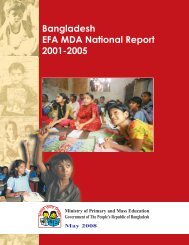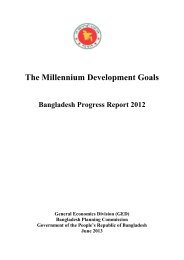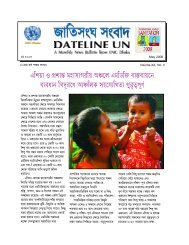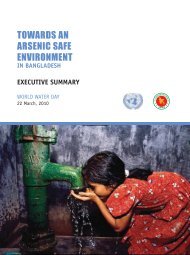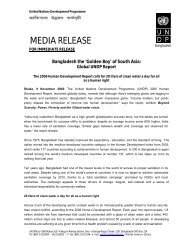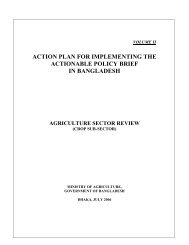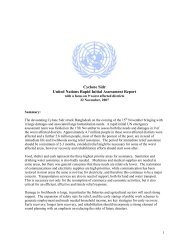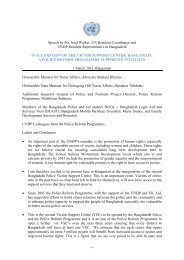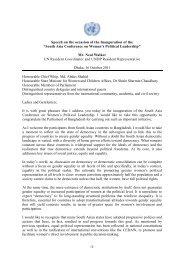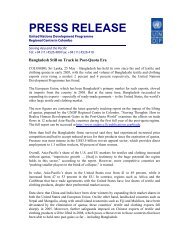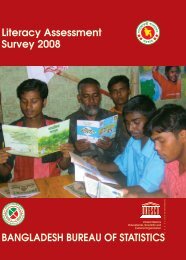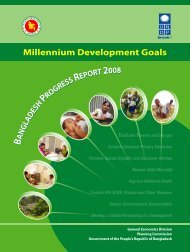Monitoring and Assessing Progress on Decent Work in Bangladesh
Monitoring and Assessing Progress on Decent Work in Bangladesh
Monitoring and Assessing Progress on Decent Work in Bangladesh
You also want an ePaper? Increase the reach of your titles
YUMPU automatically turns print PDFs into web optimized ePapers that Google loves.
per capita. This trend was accompanied by an impressive decl<strong>in</strong>e <strong>in</strong> n<strong>on</strong>-<strong>in</strong>come poverty<str<strong>on</strong>g>and</str<strong>on</strong>g> modest decl<strong>in</strong>e <strong>in</strong> <strong>in</strong>come poverty. But at the same time, the country saw the richbecom<strong>in</strong>g richer <str<strong>on</strong>g>and</str<strong>on</strong>g> the poor becom<strong>in</strong>g poorer due to various structural weaknesses of theec<strong>on</strong>omy. The <strong>in</strong>come of half of the people had decreased by the end of the period, whilethe <strong>in</strong>come of people at the middle 30 per cent marked moderate <strong>in</strong>creases <str<strong>on</strong>g>and</str<strong>on</strong>g> the top 20per cent made sharp <strong>in</strong>creases.Most fr<strong>on</strong>ts of the ec<strong>on</strong>omy enjoyed stability for most of the last five years. But as the<strong>in</strong>flati<strong>on</strong> could not be checked, people could not reap the benefits of the macroec<strong>on</strong>omicstability. Development activities of the country did not take place <strong>on</strong> the basis of nati<strong>on</strong>alpriorities or plans.No significant rise <strong>in</strong> the foreign direct <strong>in</strong>vestment (FDI) from 2001 to 2006, except <strong>in</strong>2005, was evident. The annual FDI growth rate dur<strong>in</strong>g 2002 to 2005 was <strong>on</strong> average 28 percent. The FDI growth dur<strong>in</strong>g 2002-2006 was 1 percentage po<strong>in</strong>t lower than dur<strong>in</strong>g 1996-2001. A lot of opportunities to <strong>in</strong>crease the FDI <str<strong>on</strong>g>and</str<strong>on</strong>g> create new employment could not beseized.The annual GDP growth rate dur<strong>in</strong>g 2001-2006 <strong>on</strong> average <strong>in</strong>creased to 5.7 per centcompared to 5.3 per cent dur<strong>in</strong>g 1996-2001. But more significantly, the growth rate <strong>in</strong> thelast three years exceeded 6 per cent. C<strong>on</strong>sequently, it c<strong>on</strong>tributed broadly to povertyreducti<strong>on</strong> by 1.8 per cent per year <strong>on</strong> average dur<strong>in</strong>g the last five years compared to 1 percent <strong>in</strong> the previous decade. But at the same time, social disparity c<strong>on</strong>t<strong>in</strong>ued <strong>in</strong>creas<strong>in</strong>g <strong>in</strong>the last five years, while the <strong>in</strong>come level of the poor had decreased (BBS, 2007a). Despitehigher rate of GDP growth, employment grew at a relatively slower rate of 1.6 per cent perannum imply<strong>in</strong>g a largely jobless growth for the ec<strong>on</strong>omy. With the labour force grow<strong>in</strong>gfaster than employment potential, the unemployment rate <strong>in</strong>creased over the 1990s <str<strong>on</strong>g>and</str<strong>on</strong>g>early 2000s.Aga<strong>in</strong>, high <strong>in</strong>flati<strong>on</strong> overshadowed the benefits of poverty reducti<strong>on</strong>. Dur<strong>in</strong>g 1996-2001,<strong>in</strong>flati<strong>on</strong> was largely <strong>in</strong> c<strong>on</strong>trol, though the 1998 flood had pushed it up to 8.7 per cent <str<strong>on</strong>g>and</str<strong>on</strong>g>kept it at a high of 7.1 per cent <strong>in</strong> 1999. But the <strong>in</strong>flati<strong>on</strong> rate was brought down to 2.8 percent <strong>in</strong> 2000 <str<strong>on</strong>g>and</str<strong>on</strong>g> 1.9 per cent <strong>in</strong> 2001. But the <strong>in</strong>flati<strong>on</strong> dur<strong>in</strong>g 2002-2006 marked a steadyrise from 2.8 per cent <strong>in</strong> 2002 to over 7 per cent <strong>in</strong> 2006.Although the ec<strong>on</strong>omy ma<strong>in</strong>ta<strong>in</strong>ed an overall stability, the annual budget deficit hoveredbelow a tolerable 4 per cent, while revenue collecti<strong>on</strong> <strong>in</strong>creased more than that achieveddur<strong>in</strong>g the previous period. Dur<strong>in</strong>g 2001-2006, revenue collecti<strong>on</strong> grew at 13.9 per centannually compared to 8.9 per cent dur<strong>in</strong>g 1996-2001. But it left much to be desired <strong>in</strong> thearea of the tax-GDP ratio. The <strong>in</strong>ternati<strong>on</strong>al st<str<strong>on</strong>g>and</str<strong>on</strong>g>ard for the tax-GDP ratio is a m<strong>in</strong>imumof 15 per cent; while, <strong>in</strong> <strong>Bangladesh</strong>, this hovered at 9 per cent dur<strong>in</strong>g 1996-2001 <str<strong>on</strong>g>and</str<strong>on</strong>g>reached 10.8 per cent dur<strong>in</strong>g 2002-2006.The nati<strong>on</strong>al Poverty Reducti<strong>on</strong> Strategy Paper-I (PRSP-I) was the cornerst<strong>on</strong>e of theGovernment’s nati<strong>on</strong>al development framework for meet<strong>in</strong>g the Millennium DevelopmentGoals (MDGs) by 2015 <str<strong>on</strong>g>and</str<strong>on</strong>g> SAARC Development Goals by 2010. The Three-YearRoll<strong>in</strong>g Investment Programme attempted to make the poverty reducti<strong>on</strong> strategies <str<strong>on</strong>g>and</str<strong>on</strong>g> theMDGs operati<strong>on</strong>al for the period of the fiscal year 2005 to the fiscal year 2007. Themedium-term macroec<strong>on</strong>omic framework <strong>in</strong>cluded <strong>in</strong> the PRSP-I set out a coherent macroframework which brought c<strong>on</strong>sistency am<strong>on</strong>g sav<strong>in</strong>gs, <strong>in</strong>vestment, external <str<strong>on</strong>g>and</str<strong>on</strong>g> m<strong>on</strong>etarybalances.The PRSP-I of <strong>Bangladesh</strong> outl<strong>in</strong>ed a comprehensive medium-term strategy <strong>in</strong> amacroec<strong>on</strong>omic envir<strong>on</strong>ment for implement<strong>in</strong>g pro-poor growth, effective safety-netprogrammes <str<strong>on</strong>g>and</str<strong>on</strong>g> human development. The strategy had been made broad-based <str<strong>on</strong>g>and</str<strong>on</strong>g>operati<strong>on</strong>al by emphasiz<strong>in</strong>g social <strong>in</strong>clusi<strong>on</strong> <str<strong>on</strong>g>and</str<strong>on</strong>g> empowerment, promot<strong>in</strong>g goodgovernance, highlight<strong>in</strong>g better service-delivery practices <str<strong>on</strong>g>and</str<strong>on</strong>g> <strong>in</strong>creas<strong>in</strong>g care for the3



